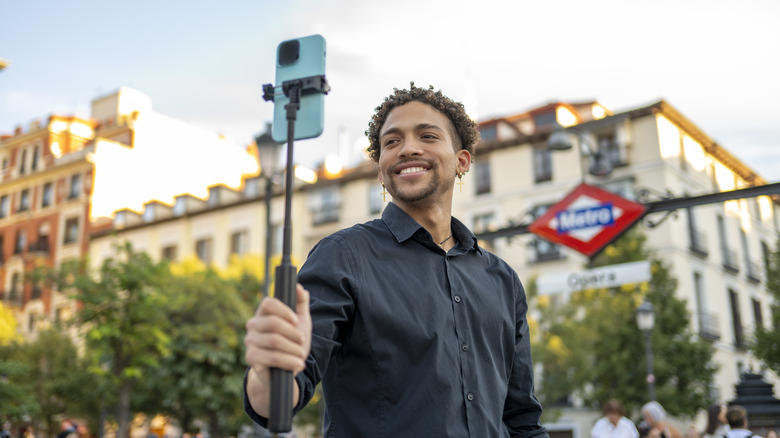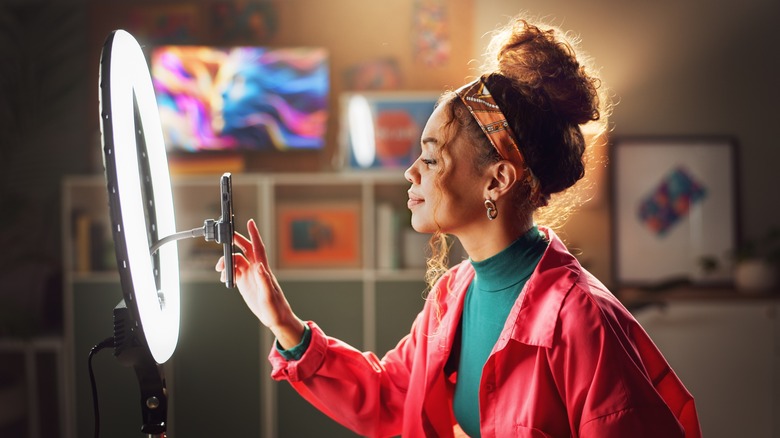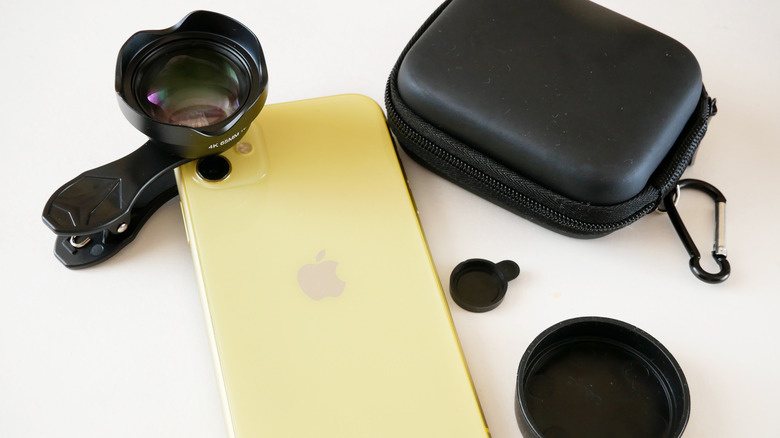5 Low-Profile Selfie Stick Alternatives That Make Travel Photos Effortless
We may receive a commission on purchases made from links.
We've all seen this person when traveling: They're standing center-stage in front of the gorgeous castle or ancient ruin that you've waited patiently with hundreds of others to see. Then, out comes the selfie stick — a long handheld extension rod you'd be forgiven for mistaking as a weapon — and with it, the collective eye-roll of the crowd. They swing it around, angling for the best photo, almost knocking out unsuspecting passersby and blocking the famed site from view. The selfie-taker seems completely oblivious to the needs of others, and everyone breathes a unanimous sigh of relief when they leave.
The once-heralded selfie stick, which boomed in popularity in 2014, was initially lauded as a genius invention. Tourists could take photos of themselves in beautiful locales without being limited by the length of their arms or the patience of a stranger. But over time, this tool became less celebrated and more despised — seen as a symbol of modern narcissism, and its users written off as vain and inconsiderate. In fact, they're so universally loathed that they've been prohibited at popular attractions like museums, sporting events, and concert venues, as they are deemed a nuisance, can endanger others, and, in the worst cases, have led to deaths. They're even one of the things banned from Disney Parks.
But regardless of your opinion on them, selfie sticks are here to stay. And although you may not identify as an influencer, you might find yourself snapping the occasional selfie — it's still a great way to preserve beautiful memories with your family, bestie, or partner. However, there are several more low-profile, less disruptive alternatives you can use to capture those photos, which we'll dive into below. Say goodbye to cumbersome — and often harmful — selfie sticks, and hello to more effortless, inconspicuously taken travel photos.
Anti-gravity case or adhesive pad
One of the best alternatives for safe, unobtrusive photo-taking is the anti-gravity phone case. This handy accessory uses nano-suction technology — thousands of microscopic suction cups that create a vacuum when pressed against a flat surface. This surprisingly strong suction power allows the case to stick — and be removed — without leaving any residue. These cases will stick to a surprisingly wide variety of smooth surfaces, including cabinets, car dashboards, mirrors, glasses, whiteboards, and more. All you need to do is find a smooth, flat surface, mount your phone, take your selfies, and peel it off when you're done. To clean it after use, run cool water over the case or wipe it with a wet cloth.
Because every phone is a different shape and design, you'll need to choose a case that fits your specific brand and model and offers the features you want. Some models are dust-resistant and add a layer of protection in case your phone does fall. Price-wise, they are relatively affordable, ranging from $4 to $13 for non-designer versions. Omio's Ultra Antigravity Case, priced at $9.99, is a decent option. The company has products that fit several of the most popular phone models, including Samsung Galaxy and iPhone. However, some reviewers have noted that the stickiness tends to wear off after a few months, so you may want to purchase some spares.
Similarly, phone case adhesives can work, too. Usually made from silicone, these double-sided, lightweight pads utilize the same suction-cup concept and can mount phones to any smooth surface. They are reusable as well and cost between $5 and $13. QWEIDHI's Phone Case Adhesive Mount, for instance, is $7.99 and comes in several different colors.
Wireless remote control
The Bluetooth remote control is a selfie game-changer. You can use it in conjunction with the aforementioned anti-gravity case or adhesives, and it lets you control your phone's camera shutter with a simple click of a button. No more desperately running across the room to jump into frame before the timer goes off! And it's small enough to easily fit inside your pocket — you won't need to fret about it appearing in the shot. You can use the remote to take a one-handed selfie without the motion blur that often occurs when you press the shutter button manually. Or you can place your phone up to 30 feet away (on most devices) and trigger the shutter once you're in position. To use it, simply pair it with your phone via Bluetooth, open your camera app, set it to video or photo mode, and use the remote to start recording or take a picture.
This item is compact and affordable: Prices range from about $5 to around $20. Zttopo's Wireless Camera Remote Shutter is listed for $7.99 and has an average rating of 4.6 stars on Amazon, across more than 8,000 reviews. It comes in a two-pack along with a wrist strap and is available in black, white, pink, and blue. It can also be set up directly with Instagram and Snapchat's camera features. On the higher end, Xenvo's Shutterbug runs $18.99 and is also well-rated (average 4.4 stars across over 3,000 reviews). It features a sleek design with a wrist strap and a keyring loop. Both of these controls are compatible with Android and Apple devices, as well as many other phone models.
Phone tripod
The tripod for cell phones — a miniature version of the variants typically used by professional videographers and photographers – is a versatile, compact tool that provides stability when shooting. As it can be placed almost anywhere and set to different heights, it's an excellent gadget for creating perfect travel images. To use the phone tripod, place it on a stable surface, adjust the legs to the desired height, insert your phone into the built-in clip, tighten it to ensure your phone is properly locked in, and get into the frame for your shot.
This piece of equipment is very reasonably priced. You'll find cheaper models as low as $6, with sturdier, higher-quality products retailing for around $20. And don't be fooled by their small size — they are surprisingly strong, with some even able to hold the weight of a DSLR camera. Many of them have a retractable design, meaning that the legs fold in and the stand can be handheld (if you still haven't been convinced to ditch the selfie stick). And most come with a wireless remote control, so you won't need to buy one separately.
One of the lower-priced options is the Ubeesize Phone Tripod: its standard model costs just over $12. It has a lightweight aluminum frame, weighing less than half a pound, and a maximum height of 10 inches. Similarly, the Lamicall Tripod comes highly rated and is available for $19.98. It stands slightly taller — 11 inches — and its phone holder can be adjusted 360 degrees horizontally, giving you a diversity of composition options. Both of these models feature twistable aluminum-wire legs, so you can wrap the tripod around bike handles, fence posts, tree trunks, or light poles, using whatever is in your environment to get the angle you need.
Hands-free mobile apps
Probably the most budget-friendly tool you can have in your selfie-taking arsenal is a mobile app that allows you to take hands-free photos without a remote control. Many of these apps cost nothing and are easily downloadable from Google Play or Apple's App Store. For example, Hey Camera gives you control of your phone's camera through customizable voice commands. These commands allow you to start and stop video recordings, take photos, and enable or disable the flash. There's also an auto-trim feature to remove your voice commands from the end of your videos. Best of all, the voice commands work offline (with iOS 13 and up), which is ideal for those shoots in remote, reception-less areas. One user commented, "There is no substitute for what this app accomplishes. It's the equivalent of having another person on hand." Hey Camera is free, available in the App Store, and only compatible with iPhones as of this writing.
Lens Buddy is another useful option that's available for both Android and iOS devices. The app offers a fully customizable timer that you can use for a single shot or multiple shots by adjusting the interval time between them. It also includes organizational features, including a built-in gallery where you can view and rate your images, saving valuable time when deciding which photos from a shoot to keep or discard. Other camera-related features include exposure control, burst mode, and tracking mode. One satisfied user raved about Lens Buddy in their review: "Genuinely I love this app ... [It's] such a huge step compared to my regular camera." Lens Buddy is free, though certain features are only available with a Pro account, which costs extra.
Wide-angle lens for phones
Finally, a wide-angle lens that attaches to your phone is a great accessory for handheld selfies and group photos, allowing you to capture more of the scene without needing to move farther back (or lengthen your arm). Generally, these lenses are compatible with most phone cameras and come with a clip that fits easily over your case. Just clip the lens over your camera and you're ready to shoot.
One option with universal compatibility is Xenvo's Pro Lens Kit, which retails for $39.99. This product doesn't just include the wide-angle lens; it also comes with a rechargeable LED clip-on light with adjustable brightness settings, a protective travel case, and a macro lens for close-up shots. This kit is ideal for anyone who wants to up their phone photography game without spending a fortune. And an even more affordable item is KEYWING's 3-in-1 Phone Lens Kit, priced at $19.99. In addition to a wide-angle and a macro lens, it includes a fisheye lens for stylized, convex, and slightly distorted images. With either kit, you'll be able to take creative, professional-looking self-portraits and travel images — effortlessly and stress-free.
Regardless of which items you choose to pack in your phone photography travel kit, remember to be mindful of others and aware of the rules at certain attractions. Some places may not allow photography or related equipment (like tripods) on site. Note that certain popular destinations even have bans on selfies themselves, as they create congestion along walkways and can put visitors at risk. And if you decide that you'd like to graduate from simple selfies and create high-quality travel shots, read these tips from the pros on how to take amazing vacation photos.





